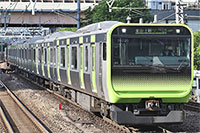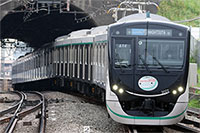Environmental and Social Issues to which Fuji Electric Contributes
Contributing to the Safe Operation of Railways with Our Railcar Door Operating Systems

As an operator in the railway business, Fuji Electric contributes to the achievement of safe and comfortable railway operations by providing electric distribution facilities such as transformers and circuit breakers, which are required for the stable supply of power to railcars and station buildings; auxiliary power supplies for supplying power to electrical equipment inside cars, such as lighting and air conditioning; main power converters for controlling railcar driving; and railcar door operating systems.
Of these, the railcar door operating systems that you might be familiar with can be classified into two types: pneumatic and electric. Pneumatic systems use air pressure to drive the doors, and electric systems use motor power. This article covers the strengths and features of the electric door operating systems that Fuji Electric manufactures.
Widespread adoption of electric door operating systems in Japan and overseas
A door operating system is a device that opens and closes doors. It is mounted at the top of the passenger entrances of railcars. They play the important role of opening and closing doors safely for passengers, especially when an object gets caught between the doors.
Pneumatic systems have been the norm for Japanese railways in the past, but electric systems offer more precise control over door opening and closing, as well as easier maintenance thanks to having fewer parts than pneumatic systems, which was realized by eliminating the need for pneumatic piping. Because of advantages like these, pneumatic systems are increasingly being replaced by electric systems. Similar trends can be observed around the world, and the need for electric door operating systems is increasing every year.
Pursuing safety through functions like door obstruction detection

Our electric door operating systems adopt the servo technology used in industrial robots, machine tools, and semiconductor manufacturing equipment. Servo technology is a technology that controls the rotational speed and position of motors with high precision, and it is capable of achieving the operation that such machines and equipment require. The servo technology we have developed in the past allows us the advantage of being able to optimally control door opening and closing. We have leveraged this strength to outfit our products with a door obstruction detection function that instantaneously reduces the force of opening or closing doors when something is detected between them, like a person’s fingers, an umbrella, or the wheels of a baby stroller or wheelchair, thereby lessening the impact and allowing passengers to easily step away or remove the object. Also, if there is any sign of an abnormality in the current value or in the time that it takes to open or close the doors, the alarm detects it automatically so that maintenance or other actions can be taken before the system malfunctions. These functions help railways to operate safely.
Supporting the commutes and lifestyles of 3 billion people around the world annually
Our market share of electric door operating systems in Japan is approximately 50% (according to our research). We have delivered these systems to the Yamanote Line of the East Japan Railway Company (JR East), the Den-en-toshi Line of TOKYU RAILWAYS, and the Chūō Line of Central Japan Railway Company (JR Central). Outside Japan, our door operating systems are used in the New York City Subway in the United States and in Singapore’s subway system, supporting the commutes and lifestyles of approximately three billion people annually with their proven usage track record and high level of safety.


(Yamanote Line, etc.)

series/6020 series/3020 series
(Den-en-toshi Line, etc.)

(Chūō Line, etc.)
Contributing to SDGs


Our door operating systems support the safety and security of passengers, punctual railway operation, and maintenance-saving performance, thereby contributing to our SDG Priority Goals “9. Industry, innovation and infrastructure” and “11. Sustainable cities and communities.”
Recommended

October 31,2025

July 2,2025

October 21,2024

October 18,2024
